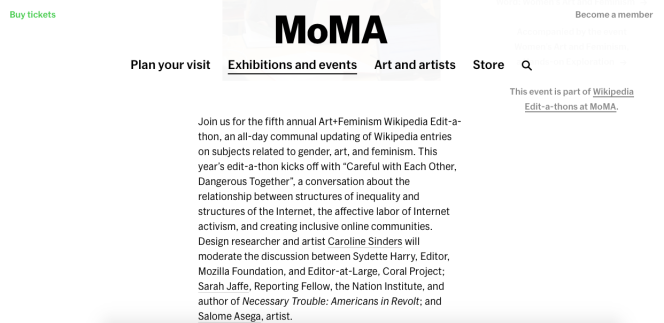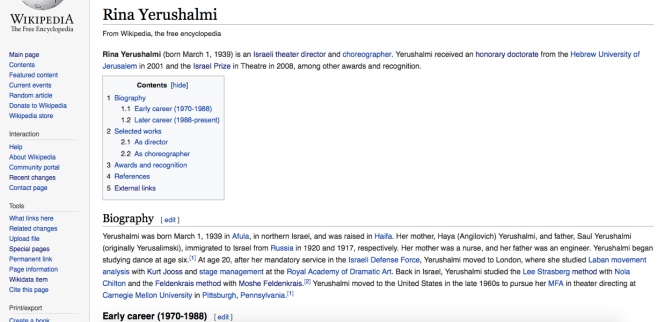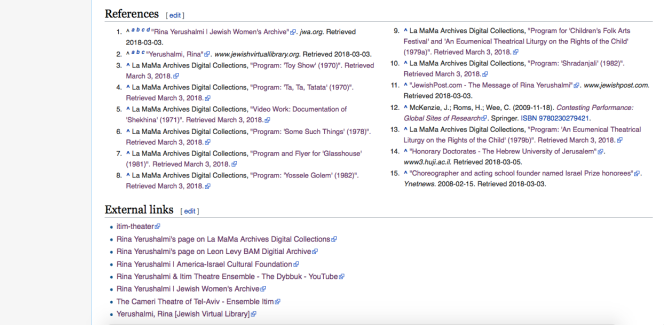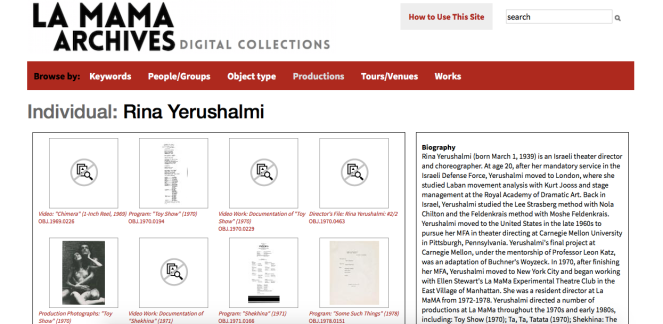In fall of 2017, La MaMa’s Archives received a $100,000 grant from the National Historical Publications and Records Commission to digitize and expand access to our collection of half-inch open reel videos. The collection documents over 150 productions that represent the enormous diversity of work being made at La MaMa during the 1970s. We have partnered with the Bay Area Video Coalition in San Francisco, where the videos are being digitized, and the Wisconsin Center for Film and Theater Research, where the digital preservation masters are being preserved in perpetuity. At the conclusion of the project, researchers will be able to view access copies of these videos at both La MaMa and WCFTR. The project will enable the public to gain unprecedented access to information about the early Off-Off-Broadway movement through an audiovisual record of work by artists ranging from John Vaccaro and the Playhouse of the Ridiculous to Hanay Geiogamah and the Native American Theatre Ensemble.
In addition to digitizing and preserving these audiovisual materials, the project aims to expand access to these materials through multiple portals. Each of the productions documented on these reels is already described on La MaMa Archives’ digital collections site, but La MaMa’s catalog is not as heavily trafficked as other websites. In order to increase the discoverability of these materials, the project is supporting shared metadata across several platforms. We are augmenting the metadata about these materials on La MaMa’s digital catalog, and then porting this metadata to the Digital Public Library of America; we are also sharing this metadata with the staff at WCFTR, who are creating a detailed finding aid that will be accessible through the University of Wisconsin’s OPAC as well as WorldCat. Additionally, we are editing Wikipedia, creating links to La MaMa’s digital catalog from Wikipedia articles about the artists and works represented on these half-inch open reel tapes. By linking from relevant Wikipedia articles to La MaMa’s digital collections site, we intend to simultaneously enhance the information available on Wikipedia about the early Off-Off-Broadway movement, increase access to La MaMa’s materials, and improve researchers’ ability to discover and learn about the artists whose work is documented by this collection – many of whom are underrepresented in the historical record and online.

Screenshot of MoMA’s event page for the edit-a-thon (https://www.moma.org/calendar/events/3941)
As the metadata/access intern for this project, one key part of my job is to develop workflows and best practices for linking the collection to relevant Wikipedia articles. Before joining this project, I’d had very little experience editing Wikipedia. This project has given me the opportunity to learn about the best practices for Wikipedia editing that have been developed by librarians, archivists, artists, activists, and others in the GLAM (Galleries, Libraries, Archives, and Museums) community. A number of GLAM-based groups are working to enhance visibility and discoverability of underrepresented people and communities on Wikipedia. One group that’s been working for several years to develop and share best practices for Wikipedia editing, in an effort to diversify the content on Wikipedia, is Art+Feminism. The group hosts Wikipedia edit-a-thons focused on improving Wikipedia’s representation of cis and trans women, feminism, and the arts. Art+Feminism’s fifth annual edit-a-thon was held at the Museum of Modern Art in Manhattan on March 3rd of this year, which was, fortuitously, one month after I joined the project at La MaMa. I attended the MoMa edit-a-thon with Rachel Mattson, the project’s Principal Investigator, and Alice Griffin, La MaMa Archives’ metadata/digitization assistant.
Having spent the month of February familiarizing myself with the collection by creating metadata and records in La MaMa’s digital collections catalog, I came to the edit-a-thon with ideas of several articles I wanted to edit. I’d been keeping a running list of the “notable” people represented in the videos and whether each had an existing Wikipedia article. Many, if not most, did not. The first production I researched when I joined the project was “Shekhina,” which was directed by Israeli theater artist Rina Yerushalmi at La MaMa in December 1971. “Shekhina” was Leon Katz’s adaptation of “The Dybbuk, or Between Two Worlds,” a Russian/Yiddish-language play written in 1914 by S. Ansky. Katz, an American playwright and scholar, had a brief Wikipedia article. Yerushalmi did not. I arrived at the edit-a-thon with the intention of creating a article for Yerushalmi.
The daylong event began with a panel discussion “about the relationship between structures of inequality and structures of the Internet, the affective labor of Internet activism, and creating inclusive online communities,” as listed on MoMA’s website. This discussion was followed by a training on Wikipedia editing led by Siân Evans, a founder of Art+Feminism and an Information Literacy and Instructional Design Librarian at the Maryland Institute College of Art in Baltimore. For me, as a beginner, this hour-long training was enormously helpful.
Among the most important things I learned was that there are established best practices for editing Wikipedia, and that adherence to these practices improves the strength of a article and decreases the likelihood of its being deleted. This knowledge has proved very valuable to me in my Wikipedia editing; because many of the artists in La MaMa’s collection are so sparsely documented, their articles are especially vulnerable. That being the case, it is crucial to adhere to the following practices as closely as possible. Art+Feminism summarizes the core best practices for editing Wikipedia as:
- stay neutral
- maintain verifiability
- no originality
- don’t be messy
- use reliable sources
- test notability, and
- know your stub (a Wikipedia article that is too short and needs to be expanded).
Of these, I was most concerned with maintaining verifiability, using reliable sources, and testing notability. (For more on rules of editing, Art+Feminism has a PDF guide on their site.) To maintain verifiability is to attribute each piece of information to a reliable source. Wikipedia defines reliable sources as books, journals, magazines, and newspapers published by mainstream presses. This definition is reasonable, though there is a useful point to be made about the absence of underrepresented people and communities in mainstream sources and the way in which this definition of reliability can reproduce and further this underrepresentation (both on Wikipedia and elsewhere). Notability also mandates that secondary sources must be available to be cited within the article. This practice guides Wikipedians to determine whether a given person, for example, merits their own article. (Wikipedia offers more on guidelines and policies for editing here).

Screenshot of Yerushalmi’s Wikipedia article (https://en.wikipedia.org/wiki/Rina_Yerushalmi)
I’d noticed, as I compiled my list of people and productions represented in La MaMa’s half-inch open reel video collection, that many did not have an existing Wikipedia article. Of those people without articles, some were notable by Wikipedia’s definition, and others were not. After Siân’s training, I began looking for secondary sources to determine whether Rina Yerushalmi would be considered notable. I did find a number of sources, primarily newspaper articles and websites, about her life and work. I spent the rest of the day creating Yerushalmi’s article. (Even after several hours of editing, the article remains far from complete, and I hope others will contribute.)

Screenshot of references and external links on Yerushalmi’s Wikipedia article (https://en.wikipedia.org/wiki/Rina_Yerushalmi)
Since the edit-a-thon, I have edited several existing Wikipedia articles for artists whose work is documented by La MaMa’s half-inch open reel video collection, including Ed Bullins, Candy Darling, Paul Foster, Tom Eyen, Hanay Geiogamah, Geraldine Keams, Elizabeth Swados, the Playhouse of the Ridiculous, Basil Anthony Wallace, and Ahmed Yacoubi. In so doing, I’ve developed a strategy that I believe maximizes the impact of my edits and citations to increase the discoverability of La MaMa’s archival collections and to support researchers’ efforts to learn about the artists represented in this collection. I make minor edits to the text of the article itself (where necessary) and link out to La MaMa’s catalog records as references for either new or existing information on the article. When editing an individual’s article, I also link out to their artist article on La MaMa’s catalog, placing this link in the “external links” section that’s often included at the end of a Wikipedia article. For example, on Rina Yerushalmi’s Wikipedia article, I linked out to “Yerushalmi’s article on La MaMa Archives Digital Collections”.

Screenshot of Yerushalmi’s page on La MaMa Archives Digital Collections (http://catalog.lamama.org/index.php/Detail/Entity/Show/entity_id/2817)
Additionally, because Wikipedia’s power as an encyclopedia is partially due to the links that editors create between articles, I’ve made sure to enhance inter-textual linking between the articles I’m editing. For example, I linked Rina Yerushalmi to Leon Katz, as well as to “The Dybbuk” and to S. Ansky. I linked playwright Ed Bullins to actor Basil Wallace, who performed in a production of Bullins one-acts at La MaMa in February/March 1972. I also linked playwright Ahmed Yacoubi to White Barn Theatre, where La MaMa produced his play “The Night Before Thinking” in July 1974, and through White Barn Theatre linked Yacoubi to Lucille Lortel, who founded the theater space in a horse barn on her Connecticut property in 1947. Through these and other links between Wikipedia articles, we hope to create more opportunities for artists and researchers to discover and access the videos in this collection and to learn about the diversity of experimental theater that was being made at La MaMa during the 1970s.